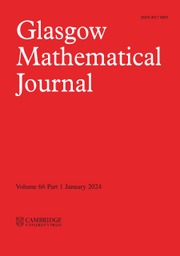Article contents
ON THE LOCAL-INDICABILITY COHEN–LYNDON THEOREM
Published online by Cambridge University Press: 01 August 2011
Abstract
For a group H and a subset X of H, we let HX denote the set {hxh−1 | h ∈ H, x ∈ X}, and when X is a free-generating set of H, we say that the set HX is a Whitehead subset of H. For a group F and an element r of F, we say that r is Cohen–Lyndon aspherical in F if F{r} is a Whitehead subset of the subgroup of F that is generated by F{r}. In 1963, Cohen and Lyndon (D. E. Cohen and R. C. Lyndon, Free bases for normal subgroups of free groups, Trans. Amer. Math. Soc. 108 (1963), 526–537) independently showed that in each free group each non-trivial element is Cohen–Lyndon aspherical. Their proof used the celebrated induction method devised by Magnus in 1930 to study one-relator groups. In 1987, Edjvet and Howie (M. Edjvet and J. Howie, A Cohen–Lyndon theorem for free products of locally indicable groups, J. Pure Appl. Algebra45 (1987), 41–44) showed that if A and B are locally indicable groups, then each cyclically reduced element of A*B that does not lie in A ∪ B is Cohen–Lyndon aspherical in A*B. Their proof used the original Cohen–Lyndon theorem. Using Bass–Serre theory, the original Cohen–Lyndon theorem and the Edjvet–Howie theorem, one can deduce the local-indicability Cohen–Lyndon theorem: if F is a locally indicable group and T is an F-tree with trivial edge stabilisers, then each element of F that fixes no vertex of T is Cohen–Lyndon aspherical in F. Conversely, by Bass–Serre theory, the original Cohen–Lyndon theorem and the Edjvet–Howie theorem are immediate consequences of the local-indicability Cohen–Lyndon theorem. In this paper we give a detailed review of a Bass–Serre theoretical form of Howie induction and arrange the arguments of Edjvet and Howie into a Howie-inductive proof of the local-indicability Cohen–Lyndon theorem that uses neither Magnus induction nor the original Cohen–Lyndon theorem. We conclude with a review of some standard applications of Cohen–Lyndon asphericity.
Information
- Type
- Research Article
- Information
- Copyright
- Copyright © Glasgow Mathematical Journal Trust 2011
References
REFERENCES
- 1
- Cited by

